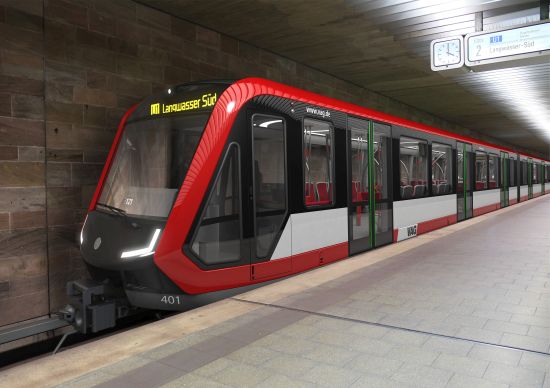Contracts exchanged: New metro trains from Siemens for Nuremberg

Copyright: ergon3design
Contracts have now been officially exchanged for the announced order from the VAG Verkehrs-Aktiengesellschaft (traffic stock corporation) for 21 metro trains from Siemens. Two options to deliver up to an additional 13 trains is also part of the contract. The new four-car trains G1 type are earmarked for service on Nuremberg's U1 line. Delivery is scheduled for mid-2018. The trains will be built in the Siemens plant in Vienna, Austria. Core components of the G1 will be manufactured in the Nuremberg metropolitan area and include such products as the drive converters, traction motors, auxiliary converter units and control equipment. The project management, development and service support will be provided from Erlangen.
Michael Richarz, Head of technology and operation at the VAG, expressed his satisfaction with the outcome of the award process: “We're pleased that we have Siemens as a partner at our side. Siemens not only has worldwide experience of rail vehicle manufacture, but is also very familiar with the conditions here in Nuremberg. After all, Siemens was the general contractor for the automation of our U2 and U3 metro lines.”
Jochen Eickholt, CEO of the Mobility Division at Siemens, said: “We've been working with the VAG for many years. So we were even more pleased when the negotiations ran successfully for us, and we could win another order to supply metro trains. The G1 type will give the VAG a train that is based on proven technology and has been developed by an experienced local team.”
The U1 line is the oldest of Nuremberg's three underground lines and is operated conventionally. It is also the longest and the most heavily frequented. It runs from Langwasser Süd via the Exhibition Center, Nuremberg Main Station and Plärrer to Hardhöhe Station, the current most westerly terminus of the line in the nearby city of Fürth. The line has an overall length of 18.5 kilometers and serves 27 stations. Ridership rises sharply when visitors come to major events, such as the Nuremberg Christmas Market and trade fairs. On weekdays, this line is mainly used by commuters.
The G1 meets these demands. Barrier-free boarding and exiting will be made even easier as the new trains have wider doors with extendable door steps to bridge the gap between car and platform. The passenger areas will offer end-to-end accessibility. In contrast to the four driver's cabs on the present Nuremberg metro trains, these new trains will have only two cabs. They will also be pre-equipped for fully automated operation, with driver's cabs designed to permit easy removal.
The eco-friendliness of the G1 will also help the City of Nuremberg reach its climate targets. Environmental protection begins at the production stage of these new G1 trains. All Siemens plants are certified according to the strictest environmental standards and all the materials used are tested for their environmental compatibility. The weight of the empty train is lower, which reduces the consumption of operating power. Braking creates energy that is recovered and used either by the train's own auxiliary equipment, such as to heat or ventilate the passenger areas, or by other trains that are running in the metro system. The interior and exterior lighting uses LED technology, which also reduces the energy consumption. At the end of their service lives, the trains can be recycled to a degree of 94.5 percent.
The VAG currently has a total of 100 two-car units in service with Siemens technology. In November 2001, the operator awarded Siemens AG an order to equip the U2 and U3 metro lines for fully automated operation and to supply 30 two-car automatic type DT3 trains. As of 2010, VAG has also received another 14 type DT3-F trains to replace its oldest DT1 trains and to serve the further extension of the U3.
This press release and press pictures are available at:
www.siemens.com/press/G1-Nuremberg
For further information on the Mobility Division, please see: www.siemens.com/mobility
Siemens AG (Berlin and Munich) is a global technology powerhouse that has stood for engineering excellence, innovation, quality, reliability and internationality for more than 165 years. The company is active in more than 200 countries, focusing on the areas of electrification, automation and digitalization. One of the world's largest producers of energy-efficient, resource-saving technologies, Siemens is No. 1 in offshore wind turbine construction, a leading supplier of gas and steam turbines for power generation, a major provider of power transmission solutions and a pioneer in infrastructure solutions as well as automation, drive and software solutions for industry. The company is also a leading provider of medical imaging equipment – such as computed tomography and magnetic resonance imaging systems – and a leader in laboratory diagnostics as well as clinical IT. In fiscal 2015, which ended on September 30, 2015, Siemens generated revenue of €75.6 billion and net income of €7.4 billion. At the end of September 2015, the company had around 348,000 employees worldwide.
Further information is available on the Internet at www.siemens.com
Reference Number: PR2015120104MOEN
Contact
Ms. Ellen Schramke
Mobility Division
Siemens AG
Nonnendammallee 101
13629 Berlin
Germany
Tel: +49 (30) 386-22370
ellen.schramke@siemens.com
All latest news from the category: Corporate News
Newest articles

A ‘language’ for ML models to predict nanopore properties
A large number of 2D materials like graphene can have nanopores – small holes formed by missing atoms through which foreign substances can pass. The properties of these nanopores dictate many…

Clinically validated, wearable ultrasound patch
… for continuous blood pressure monitoring. A team of researchers at the University of California San Diego has developed a new and improved wearable ultrasound patch for continuous and noninvasive…

A new puzzle piece for string theory research
Dr. Ksenia Fedosova from the Cluster of Excellence Mathematics Münster, along with an international research team, has proven a conjecture in string theory that physicists had proposed regarding certain equations….



